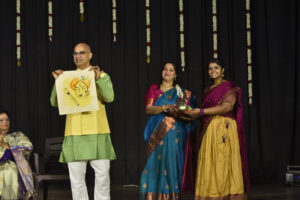For every Bharatanatyam dancer, the arangetram ceremony meaning goes far beyond just a stage performance. It is a spiritual and cultural milestone marking years of discipline, training, and devotion. Derived from the Tamil words “Arangu” (stage) and “Etram” (ascending), arangetram symbolizes the dancer’s first formal entry onto the stage after years of preparation under the guidance of a guru. It is not simply a test of skill but also a celebration of tradition, culture, and the unbreakable bond between the guru and the shishya (student). Experiencing this journey is considered essential because it completes a dancer’s learning cycle, giving them the confidence to perform independently while honoring the sacred roots of Bharatanatyam.
1. Defining Arangetram
The Bharatanatyam arangetram ceremony meaning represents a transition—a dancer moves from being a student to a performer capable of carrying forward this classical art form. Arangetram is not just about memorizing steps or perfecting expressions; it is about embodying the philosophy and spirituality of Bharatanatyam. The dancer must demonstrate mastery over rhythm (tala), melody (raga), expression (abhinaya), and storytelling (natya). It is the culmination of years of dedication, often requiring over seven to ten years of rigorous training. This defining moment acknowledges that the student is now ready to share their art with the world.
2. What is an Arangetram Ceremony?
So, what is arangetram ceremony in simple terms? It is a formal solo dance debut where the student performs a full repertoire in front of an audience. This usually includes alarippu, jatiswaram, varnam, padams, and tillana, each section testing different aspects of a dancer’s technique, stamina, and expressiveness. The program often lasts two to three hours, demanding both physical endurance and mental focus. Families treat the occasion with great reverence, and it is often compared to a graduation ceremony in the world of performing arts. Along with the performance, traditions such as honoring the guru and exchanging Arangetram gift items with guests highlight the ceremonial value of the event.
3. The Cultural Significance
To understand why arangetram is important, one must see it through the lens of culture and tradition. Bharatanatyam is not just a dance; it is a form of devotion and storytelling rooted in temple rituals. By performing arangetram, the dancer symbolically carries forward this sacred lineage. It is also an occasion to express gratitude—to the guru for imparting knowledge, to the family for their support, and to the divine for blessing the journey. Additionally, the ceremony reinforces the cultural identity of the Indian diaspora worldwide, allowing communities to stay connected to their roots. It is this cultural and spiritual richness that makes arangetram more than just a performance.
4. Bharatanatyam Performance in Context
The arangetram performance itself is a balance of technical precision and emotional depth. Each piece in the repertoire reflects centuries of tradition, from rhythmic footwork that syncs with the mridangam to abhinaya that narrates stories from epics like the Ramayana, Mahabharata and Krishna leela. The dancer’s costume, jewelry, and makeup are designed to enhance expressions, making every mudra visible to the audience. The Bharatanatyam arangetram cost often reflects the grandeur of the event, covering aspects like costumes, stage arrangements, orchestra, and professional photography. While some families choose simple setups, others prefer elaborate celebrations, but in all cases, the focus remains on showcasing the dancer’s journey and dedication.
5. Audience Engagement
A unique feature of the arangetram is the way it engages the audience. Viewers are not just spectators; they are witnesses to a dancer’s transformation. Friends, family, and art enthusiasts gather to celebrate the student’s achievement, often offering blessings, encouragement, and thoughtful Arangetram gift items. The event creates a shared sense of pride, not only for the performer but also for the entire community supporting classical arts. Audience members also gain a deeper appreciation of Bharatanatyam through the storytelling elements woven into the performance. The connection forged between dancer and audience ensures that the art form continues to inspire new generations.
6. Conclusion
The arangetram ceremony meaning extends far beyond the stage. It is a blend of tradition, culture, spirituality, and personal growth. By completing an arangetram, a dancer not only proves technical mastery but also takes on the responsibility of preserving and promoting Bharatanatyam. Whether through the symbolism of the repertoire, the cultural pride it instills, or the emotional bond it fosters between guru, student, and audience, the significance of this ceremony is profound. In essence, arangetram is not just a performance—it is a rite of passage, a spiritual offering, and a lifelong memory.





